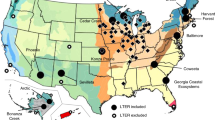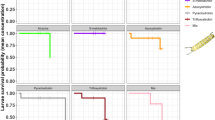Abstract
Recent studies have shown that neonicotinoid insecticides have adverse effects on non-target invertebrate species1,2,3,4,5,6. Invertebrates constitute a substantial part of the diet of many bird species during the breeding season and are indispensable for raising offspring7. We investigated the hypothesis that the most widely used neonicotinoid insecticide, imidacloprid, has a negative impact on insectivorous bird populations. Here we show that, in the Netherlands, local population trends were significantly more negative in areas with higher surface-water concentrations of imidacloprid. At imidacloprid concentrations of more than 20 nanograms per litre, bird populations tended to decline by 3.5 per cent on average annually. Additional analyses revealed that this spatial pattern of decline appeared only after the introduction of imidacloprid to the Netherlands, in the mid-1990s. We further show that the recent negative relationship remains after correcting for spatial differences in land-use changes that are known to affect bird populations in farmland. Our results suggest that the impact of neonicotinoids on the natural environment is even more substantial than has recently been reported and is reminiscent of the effects of persistent insecticides in the past. Future legislation should take into account the potential cascading effects of neonicotinoids on ecosystems.
This is a preview of subscription content, access via your institution
Access options
Subscribe to this journal
Receive 51 print issues and online access
$199.00 per year
only $3.90 per issue
Buy this article
- Purchase on Springer Link
- Instant access to full article PDF
Prices may be subject to local taxes which are calculated during checkout


Similar content being viewed by others
Change history
13 October 2014
ED Figs 2, 5 and 6 were corrected on 13 Oct 2014
References
Gill, R. J., Ramos-Rodriguez, O. & Raine, N. E. Combined pesticide exposure severely affects individual- and colony-level traits in bees. Nature 491, 105–108 (2012)
Henry, M. et al. A common pesticide decreases foraging success and survival in honey bees. Science 336, 348–350 (2012)
Whitehorn, P. R., O’Connor, S., Wackers, F. L. & Goulson, D. Neonicotinoid pesticide reduces bumble bee colony growth and queen production. Science 336, 351–352 (2012)
Van Dijk, T. C., van Staalduinen, M. A. & van der Sluijs, J. P. Macro-invertebrate decline in surface water polluted with imidacloprid. PLoS ONE 8, e62374 (2013)
Easton, A. H. & Goulson, D. The neonicotinoid insecticide imidacloprid repels pollinating flies and beetles at field-realistic concentrations. PLoS ONE 8, e54819 (2013)
Roessink, I., Merga, L. B., Zweers, H. J. & van den Brink, P. J. The neonicotinoid imidacloprid shows high chronic toxicity to mayfly nymphs. Environ. Toxicol. Chem. 32, 1096–1100 (2013)
Cramp, S. & Perrins, C. M. The Birds of the Western Palearctic (Oxford Univ. Press, 1994)
Goulson, D. An overview of the environmental risks posed by neonicotinoid insecticides. J. Appl. Ecol. 50, 977–987 (2013)
Matsuda, K. et al. Neonicotinoids: insecticides acting on insect nicotinic acetylcholine receptors. Trends Pharmacol. Sci. 22, 573–580 (2001)
Tomizawa, M. & Casida, J. E. Neonicotinoid insecticide toxicology: mechanisms of selective action. Annu. Rev. Pharmacol. Toxicol. 45, 247–268 (2005)
Pollak, P. Fine Chemicals: The Industry and the Business (Wiley, 2011)
Statistics Netherlands. StatLine Databank http://statline.cbs.nl/statweb/ (2013)
Institute of Environmental Sciences, Leiden University and Rijkswaterstaat-Water Services. Dutch Pesticides Atlas http://www.bestrijdingsmiddelenatlas.nl (2009)
Newton, I. Population Limitation in Birds (Elsevier, 1998)
Boatman, N. D. et al. Evidence for the indirect effects of pesticides on farmland birds. Ibis 146, 131–143 (2004)
Poulin, B., Lefebvre, G. & Paz, L. Red flag for green spray: adverse trophic effects of Bti on breeding birds. J. Appl. Ecol. 47, 884–889 (2010)
Van Turnhout, C. A. M., Foppen, R. P. B., Leuven, R. S. E. W., van Strien, A. & Siepel, H. Life-history and ecological correlates of population change in Dutch breeding birds. Biol. Conserv. 143, 173–181 (2010)
Van Turnhout, C. A. M., Foppen, R. P. B., Leuven, R. S. E. W., Siepel, H. & Esselink, H. Scale-dependent homogenization: changes in breeding bird diversity in the Netherlands over a 25-year period. Biol. Conserv. 134, 505–516 (2007)
Newton, I. The recent declines of farmland bird populations in Britain: an appraisal of causal factors and conservation actions. Ibis 146, 579–600 (2004)
Chamberlain, D. E. & Fuller, R. J. Local extinctions and changes in species richness of lowland farmland birds in England and Wales in relation to recent changes in agricultural land-use. Agric. Ecosyst. Environ. 78, 1–17 (2000)
Fuller, R. J. in Ecology and Conservation of Lowland Farmland Birds (eds Aebischer, N. J., Evans, A. D., Grice, P. V. & Vickery, J. A. ) 5–16 (British Ornithologists’ Union, 2000)
Gregory, R. D. et al. Developing indicators for European birds. Phil. Trans. R. Soc. Lond. B 360, 269–288 (2005)
Geiger, F. et al. Persistent negative effects of pesticides on biodiversity and biological control potential on European farmland. Basic Appl. Ecol. 11, 97–105 (2010)
Mineau, P. & Whiteside, M. Pesticide acute toxicity is a better correlate of US grassland bird declines than agricultural intensification. PLoS ONE 8, e57457 (2013)
Bibby, C. J., Burgess, N. D. & Hill, D. A. Bird Census Techniques (Academic, 1992)
van Dijk, A. J. Handleiding Broedvogel Monitoring Project (Sovon Vogelonderzoek Nederland, 2004)
Devictor, V. et al. Differences in the climatic debts of birds and butterflies at a continental scale. Nature Clim. Chang. 2, 121–124 (2012)
Kampichler, C., van Turnhout, C. A. M., Devictor, V. & van der Jeugd, H. P. Large-scale changes in community composition: determining land use and climate change signals. PLoS ONE 7, e35272 (2012)
Acknowledgements
We thank A. J. van Dijk, H. Sierdsema and D. Zoetebier for processing the bird data sets and J. P. van der Sluijs for sharing the database with imidacloprid concentration measurements. The Breeding Bird Monitoring Program is organised in close collaboration with Statistics Netherlands and provinces and is funded by the Dutch Ministry of EZ. We thank Sovon volunteers for their efforts in the field. The study was supported by NWO grants 840.11.001 and 841.11.007 and was the result of a collaboration within the Center for Avian Population Studies.
Author information
Authors and Affiliations
Contributions
C.A.H. performed the statistical analysis. C.A.H., R.P.B.F., C.A.M.v.T., H.d.K. and E.J. wrote the manuscript.
Corresponding author
Ethics declarations
Competing interests
The authors declare no competing financial interests.
Extended data figures and tables
Extended Data Figure 2 Distribution of the 354 bird monitoring plots in the Netherlands.
The figure depicts the spatial distribution of bird monitoring plots from which local species-specific trends were calculated.
Extended Data Figure 3 Spatial and serial (yearly) autocorrelation of imidacloprid measurements.
a, Semivariance (dots) and Matern variogram model (fitted line) used in the interpolation of the concentrations (nugget = 0.1901, sill = 1.6989, range = 13.2 km). b, Serial correlation (between years) of imidacloprid concentrations. Each value gives the number of pairs of measurements at each year lag that were used to calculate the coefficients. Serial correlations remain invariant with respect to temporal lag, indicating high temporal consistency in local imidacloprid concentrations.
Extended Data Figure 4 Population trends as a function of imidacloprid concentration per individual bird species.
The red lines depict the weighted mean trend, also given as slope coefficients (β) and with corresponding P values.
Extended Data Figure 5 Robustness check for the effect of the cut-off value for the distance between bird monitoring plots and water measurement locations (varied between 1 and 25 km).
The larger the cut-off distance, the more species–plot annual rates of increase are retained in the analysis subset of the total database of 3,947 records (a) but at the cost of increased noise in the response and a decrease in the effect of imidacloprid on the bird trends (b). However, in all cases, the effect of imidacloprid was significant and negative (P < 0.0001).
Extended Data Figure 6 Bird species trends before and after imidacloprid introduction.
Comparison of the relationship of bird species trends in the periods 1984–1995 (a) and 2003–2010 (b) with the imidacloprid concentrations in 2003–2009, based on all plots monitored in both time periods. Each point in the scatter plot represents the average intrinsic rate of increase of a species over all plots in the same concentration class. Binning into classes was performed to reduce scatter noise and aid in visual interpretation. The actual analyses and the depicted significant regression line were based on raw data. The bird trends were significantly affected by the imidacloprid concentration in 2003–2010 (t = −2.16, d.f. = 365, P = 0.031) but were not significantly affected in the period before imidacloprid administration (t = −1.43, d.f. = 365, P = 0.15).
Supplementary information
Supplementary Information
This file contains Supplementary Data, Supplementary Methods and Supplementary References. (PDF 158 kb)
PowerPoint slides
Source data
Rights and permissions
About this article
Cite this article
Hallmann, C., Foppen, R., van Turnhout, C. et al. Declines in insectivorous birds are associated with high neonicotinoid concentrations. Nature 511, 341–343 (2014). https://doi.org/10.1038/nature13531
Received:
Accepted:
Published:
Issue Date:
DOI: https://doi.org/10.1038/nature13531
This article is cited by
-
Weather explains the decline and rise of insect biomass over 34 years
Nature (2024)
-
Diverse cropping systems lead to higher larval mortality of the cabbage root fly (Delia radicum)
Journal of Pest Science (2024)
-
Fungicide-free management of Alternaria leaf blotch and fruit spot on apple indicates Alternaria spp. as secondary colonizer
Scientific Reports (2023)
-
A nationwide collapse of a priority grassland bird related to livestock conversion and intensification
Scientific Reports (2023)
-
Common seed dispersers contribute most to the persistence of a fleshy-fruited tree
Communications Biology (2023)
Comments
By submitting a comment you agree to abide by our Terms and Community Guidelines. If you find something abusive or that does not comply with our terms or guidelines please flag it as inappropriate.



